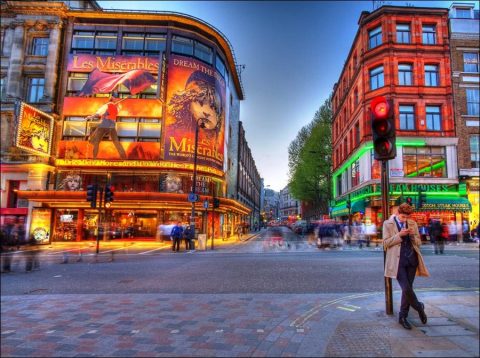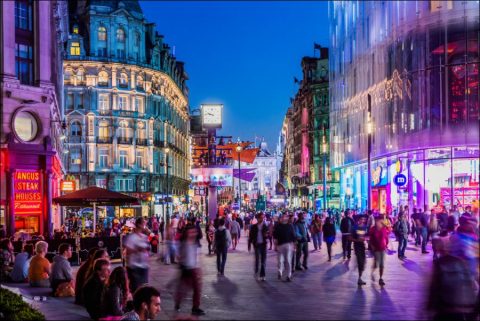Wise men, who are said to come from the East, may explain to us why the star of fashion, to which the rich and proud hitch their vehicles, tends to take its way westward. One of the most common place-names in England, indeed, is Sutton, but Weston is also frequent, whereas Nortons and Eastons are much rarer. So strong is the tug of the West, that this end of any city seems aptest to win a repute as its choicest quarter, its Champs Elysées, its Pera, out off by a social gulf from the Stamboul of business. Even at our holiday resorts, witness Brighton, Eastbourne, and Hastings, it is the western horn that tends to be exalted as more select.
The growth of this side of London is an old story. Lords and prelates once lived snug within the walls of the City, then stretched their mansions along the banks of the Thames towards Westminster. Covent Garden and Lincoln’s Inn Fields were the first squares of gentility, dating from Inigo Jones. Bloomsbury, Soho, and St. James’s Squares arose under Charles II. Hanoverian princes, while waiting to occupy St. James’s or Kensington, were still content to house themselves near Charing Cross.
But by Pall Mall and Piccadilly the tide of fashion set westward, ebbing out of Leicester Square as in our own day we see the family mansions of St. James’s Square dried up into clubs and offices. Berkeley Square was begun when Lord Burlington built his house as the last in Piccadilly, to have his view westward presently blocked by the Duke of Devonshire, who again was cut out by Lord Coventry at what is now Brick Street.
Still farther west, where Apsley House in time came to stand, the tavern which welcomed Squire Western on his way from Somerset took the sign of the “Hercules’ Pillars,” as marking the end of a known world. Mayfair, thus invaded, had been a rather disreputable neighbourhood, noted for its vulgar market, of which a fragment still holds out behind the clubs of Piccadilly, and for a chapel that, like that of the Fleet, did scandalous business in irregular marriages. But George III.’s reign saw this ragged outskirt reformed to become the most fashionable district of London, with Grosvenor Square as its now centre, while across Oxford Street Portman Square made the lobe of other arteries that are not now so well filled with blue blood.
Disraeli seems to have been at least a little “previous” when he put Oxford Street as a natural boundary like the Rhine, cutting off the true West End from “all those flat, dull, spiritless streets, resembling one another like a large family of plain children with Portland Place and Portman Square for their respectable parents.” Not to speak of a royal princess, there are still half a dozen dukes and earls in Portman Square, where lived the head of the noble family with which Mr. Tittlebat Titmouse claimed kindred.
The City of Westminster is dotted, not so thickly as it might be, with tablets proclaiming celebrated occupants of this or that house, as, for instance, one near the corner of King Street, off St. James’s Square, which lodged Louis Napoleon in his conspiring days. Many houses, of course, can be more or less authoritatively identified with real or fictitious personages: a friend of mine who lived in Curzon Street felt certain that Becky Sharp had been among his predecessors. Lord Beaconsfield certainly died at No. 19, as he lived in his palmy days at 29, Park Lane. Gladstone is remembered in several homes, beginning with the chambers of the Albany, that have lodged so many celebrities in their youth.
In one house of Berkeley Square lived Horace Walpole, in another Clive killed himself; and others could be pointed out as once the abodes of Lord Brougham and of Lord Clyde, if we cared for a complete directory of ghostly addresses thus distinguished. In Berkeley Square is a house long noted for the name of being haunted in our own time; but Lady Dorothy Nevill, in a position to probe this bad reputation, reduces its weird legend to a story of an eccentric tenant, disappointed in love, who let it go to rack and ruin for twenty years, during which he never went out, moving about the rooms only at night, when the windows showed mysterious lights in what was taken for an unoccupied building.
Nobody knows for certain how Piccadilly came by its outlandish name, at which doubtful guesses have been made. The names of its side streets often show how they were once the demesnes of noble families, whose mansions may still stand islanded among rows of unsecluded homes–Grosvenor House, Lansdowne House, Bath House, Chesterfield House, and so on, beside the pretentious palaces recently raised by South African millionaires and the like.
The site of these houses must be a most valuable property in unearned increment; and if their owners cannot come to terms with an American heiress, they might always get new gilding for a coronet by selling such roomy town seats to be changed into blocks of flats. It is whispered, indeed, that the first crop of Mayfair flats has yielded a poorer harvest than was expected; so this new form of domesticity may be expected to flourish rather in the suburbs and in the purlieus of fashion, where it takes deeper root. People who can afford thousands of pounds a year for an apartment, may still prefer the old self-contained house, though, in the West-end, it is apt to be a model of inconvenience, especially in the bedroom and kitchen arrangements that will not meet the eye of guests, nor of passers-by admiring its fresh coat of paint and beflowered window-sills.
Farther out, where fashion does not silver such discomforts, there seems a sad slump in last generation’s homes of respectability, with their deep-sunk areas and long stairs, standing to let by hundreds in certain monotonous streets that hold desperately on to the skirts of gentility. Dear in proportion, and most difficult to get in the West-end, are small houses adapted to the failing supply of domestic service; and this explains the success of the flats that seek to add a new dimension to housing space.
Hits: 577

